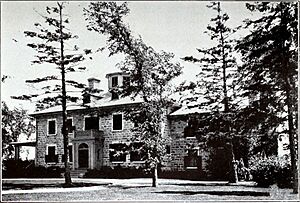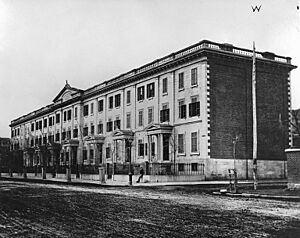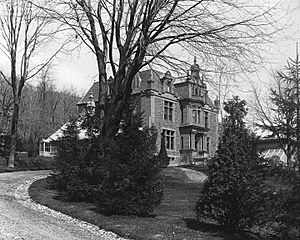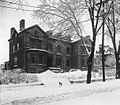George Simpson (HBC administrator) facts for kids
Quick facts for kids
Sir
George Simpson
|
|
|---|---|
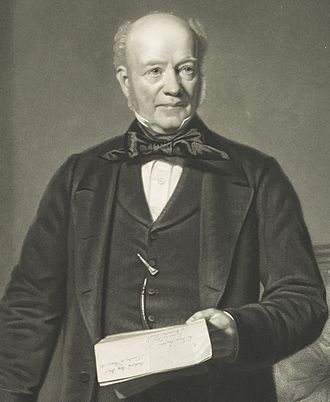
Simpson in a portrait by Stephen Pearce
|
|
| Governor-in-Chief of Rupert's Land | |
| In office 29 March 1821 – 7 September 1860 |
|
| Preceded by | William Williams |
| Succeeded by | William MacTavish |
| Charter | Hudson's Bay Company |
| Personal details | |
| Born | Unknown date, c. 1792 Dingwall, Ross-shire, Scotland |
| Died | (aged 68) Lachine, Province of Canada |
| Resting place | Mount Royal Cemetery |
| Spouse | Frances Ramsay Simpson |
| Children | 11 |
| Relatives | Thomas Simpson (nephew) |
| Awards | Knight Bachelor (1841) |
| Signature |  |
Sir George Simpson (around 1792 – September 7, 1860) was a Scottish explorer and an important leader of the Hudson's Bay Company. This was when the company was at its most powerful. From 1820 to 1860, he was like a British governor for a huge area called Rupert's Land. This land was about 3.9 million square kilometers, which is almost 40% of modern-day Canada.
His excellent management of the western lands helped prepare the way for Canadian Confederation. This event later created the country of Canada. Simpson was known for his attention to detail and his amazing ability to travel long distances. He spent a lot of time exploring the wilderness. He was also the first known person to travel "around the world" by land.
Contents
Sir George Simpson: Early Life and Career
George Simpson was born in Dingwall, Scotland, around 1792. He was raised by his aunts and grandmother. His family had connections to important people, including the explorer Sir Alexander Mackenzie.
In 1808, he moved to London to work in a sugar business. This business later joined with another company in 1812. Through this, Simpson met people connected to the Hudson's Bay Company. One of these people was Andrew Colvile-Wedderburn, a director of the company.
Starting in the Fur Trade
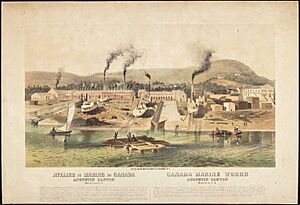
At this time, the Hudson's Bay Company (HBC) was in a tough competition with the North West Company. There were even conflicts and arrests between the two groups. The British government wanted them to stop fighting. In 1820, Simpson was sent to Canada to help manage things.
He traveled from New York to Montreal and then by boat to York Factory on Hudson Bay. He started learning about the fur trade and how to organize it better. In 1821, the two rival companies merged. This ended the costly competition and made the HBC very powerful.
Simpson became the governor of the Northern Department, which covered the western parts of the territory. The HBC's control then stretched all the way to the Pacific coast. He traveled widely to inspect and reorganize the trading posts.
Journeys and Exploration
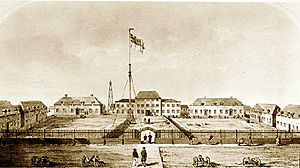
In 1824, Simpson began a major journey to the Pacific Ocean. He traveled faster than anyone before him, reaching the mouth of the Columbia River in just 80 days. He decided to move the main office of the Columbia District to Fort Vancouver. He thought this would be safer from American claims.
He returned to Britain in 1825. When he came back to Canada, he was made governor of the entire Hudson's Bay Company territory. This meant he was in charge of a vast area. He continued to travel extensively, inspecting posts and managing the fur trade.
In 1828, he made another long trip to the Pacific, traveling about 5,000 miles by canoe. This was one of the longest canoe journeys ever made in North America in one season. He later married his cousin, Frances Ramsay Simpson, in 1830.
Sir George Simpson: Around the World Journey
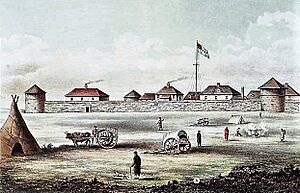
Simpson is famous for being the first person known to travel around the world mostly by land. He left London in March 1841. He traveled by canoe to Fort Garry (now Winnipeg). He then rode on horseback to Fort Edmonton.
Instead of his usual route, he went through what is now Banff, Alberta. He made the first recorded trip through Simpson Pass, which is named after him. He then went down the Kootenay River to Fort Vancouver.
Simpson suggested moving the HBC headquarters to what is now Victoria, British Columbia. He thought this location would be better because of the border with the United States. He sailed along the Pacific coast, visiting Russian posts in Alaska and even stopping in California.
He then sailed to Hawaii in 1842. From there, he took a Russian ship to Siberia. He traveled by horse and carriage across Russia to Saint Petersburg. Finally, he reached London by ship in October 1842. He wrote a book about this amazing journey called An overland journey round the world.
Helping Hawaii
During his visit to Hawaii, Simpson met with King Kamehameha III. Simpson helped Hawaii gain independence. He worked with Hawaiian representatives to get Great Britain and France to officially recognize Hawaii as an independent nation. This was a big achievement for Hawaii.
Sir George Simpson: Later Life and Legacy
By this time, Simpson and his wife lived in a large house in Lachine, Quebec. He also owned other properties. He often hosted important people at his home. He started investing in many businesses like banks, railroads, ships, and mines. He became a director and shareholder in Canada's first bank, the Bank of Montreal.
He also invested in many railway companies. His business partners included some of Canada's richest and most influential people. In 1845, he discussed the Oregon border with American and British leaders. The Oregon Treaty in 1846 set the current border.
Simpson continued to travel and work for the Hudson's Bay Company. In August 1860, he hosted the Prince of Wales at his home in Lachine. The Prince was there for the opening of the Victoria Bridge. Simpson even built a row of luxurious houses called Prince of Wales Terrace in his honor.
A street in Montreal, Simpson Street, was named after him. This street was in a very wealthy area of Montreal called the Golden Square Mile. This area held a large part of Canada's wealth. Simpson was one of the most important people in the North American fur trade.
Shortly after the Prince of Wales's visit, Sir George Simpson passed away in Lachine in September 1860. He left behind a large fortune. He also gave money to McGill University.
Many people consider Sir George Simpson one of Canada's founding fathers. He played a key role as Governor-in-chief of Rupert's Land. This huge territory later became part of Canada in 1867. Rupert's Land was the largest land acquisition that helped form modern Canada. It included parts of Quebec, Ontario, Manitoba, Saskatchewan, Alberta, and even parts of the United States.
Simpson was known by many nicknames, such as the King of the Fur-trade and the Emperor of the North. He greatly admired Napoleon and collected many items related to him. He even decorated his offices with Napoleonic prints.
Images for kids
-
Sir George Simpson's residence on his island named L'Île-Dorval, where he received the Prince of Wales.



